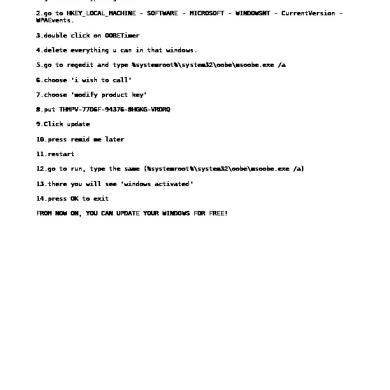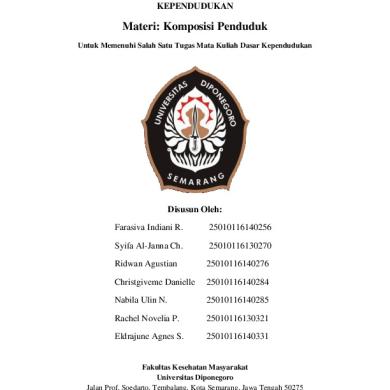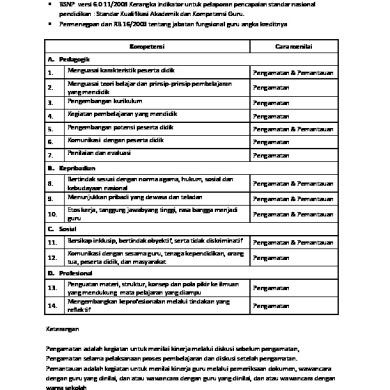Important Terms (linear Motion)
This document was uploaded by user and they confirmed that they have the permission to share it. If you are author or own the copyright of this book, please report to us by using this DMCA report form. Report DMCA
Overview
Download & View Important Terms (linear Motion) as PDF for free.
More details
- Words: 684
- Pages: 4
2.1 Linear Motion
Distance Distance is defined as the total path traveled by an object from one point to the other. Displacement Displacement is defined as the shortest distance between two point in a specific direction. Speed Speed is defined as the rate of change of distance. Velocity Velocity is defined as the rate of change of displacement. Acceleration Acceleration is defined as the rate of change of velocity. Deceleration Deceleration is the rate of decrease of velocity or how fast a velocity of a moving object decreases.
2.3 Inertia Inertia Inertia is the tendency of an object resist to change its motion state. An object at rest will tend to remain at rest, or if moving will tend to continue its motion in a straight line.
2.4 Momentum Momentum The momentum of an object is the product of the mass and the velocity of the object. Law of Conservation Of Momentum In a reaction between objects (collision or explosion), the total momentum before the reaction is equal to the total momentum after the reaction, provided that no external force acts on the system. Elastic Collision Elastic collision is the collision where the kinetic energy is conserved after the collision. Inelastic Collision Inelastic collision is the collision where the kinetic energy is not conserved after the collision.
2.5 Effects of Force Newton’s First Law In the absence of external forces, an object at rest remains at rest and an object in motion continues in motion with a constant velocity (that is, with a constant speed in a straight line). Newton’s Second Law The rate of change of momentum of a body is directly proportional to the resultant force acting on the body and is in the same direction. Newton’s Third Law Newton's third law of motion states that for every force, there is a reaction force with the same magnitude but in the opposite direction. Friction Friction is a force opposing motion. How the crumble zone of a car can reduce injuries to passenger? Friction Compensated Runway A friction compensated run way is a runway which the friction of an object placed on it is balanced by the weight of the object itself.
2.6 Impulse and Impulsive Force
Impulse Impulse is defined as the product of a force F acting on an object for a time, t. Impulsive Force Impulsive force is a force which acts on an object for a very short interval during a collision or explosion. It is equals to the change in momentum per unit time.
2.7 Safety Features in Vehicles How the crumble zone of a car can reduce injuries to passenger? The crumple zone increases the time of collision. This causes the impulsive force to be small. The smaller the impulsive force, the smaller the injuries Seat Belt Prevent the driver and passengers from being flung forward or thrown out of the car during an emergency break. Airbag The inflated airbag during an accident acts as a cushion to lessen the impact when the driver flings forward hitting the steering wheel or dashboard. Head Rest Reduce neck injury when driver and passengers are thrown backwards when the car is banged from backward.
2.8 Gravity Mass Mass is defined as quantity of matter. The S.I. unit of mass is kg. Weight Weight of an object is the gravitational force acting on the object. Gravitational Field Strength Gravitational Acceleration
2.9 Force in Equilibrium
Equilirium of Force Forces acting on an object are in equilibrium if the net force acting on the object is zero.
2.10 Work, Energy, Power and Efficientcy Work Work done by a constant force is given by the product of the force and the distance moved in the direction of the force. Energy Energy is capacity to do work. Power Power is the rate of work done or the rate of energy conversion.
2.11 Eleasticity Spring Constant Spring/force constant is the force required to extend the spring by one unit of extension. Hooke’s Law Hooke's law states that the extension of a spring is directly proportional to the applied force provided the elastic limit is not exceeded.
Distance Distance is defined as the total path traveled by an object from one point to the other. Displacement Displacement is defined as the shortest distance between two point in a specific direction. Speed Speed is defined as the rate of change of distance. Velocity Velocity is defined as the rate of change of displacement. Acceleration Acceleration is defined as the rate of change of velocity. Deceleration Deceleration is the rate of decrease of velocity or how fast a velocity of a moving object decreases.
2.3 Inertia Inertia Inertia is the tendency of an object resist to change its motion state. An object at rest will tend to remain at rest, or if moving will tend to continue its motion in a straight line.
2.4 Momentum Momentum The momentum of an object is the product of the mass and the velocity of the object. Law of Conservation Of Momentum In a reaction between objects (collision or explosion), the total momentum before the reaction is equal to the total momentum after the reaction, provided that no external force acts on the system. Elastic Collision Elastic collision is the collision where the kinetic energy is conserved after the collision. Inelastic Collision Inelastic collision is the collision where the kinetic energy is not conserved after the collision.
2.5 Effects of Force Newton’s First Law In the absence of external forces, an object at rest remains at rest and an object in motion continues in motion with a constant velocity (that is, with a constant speed in a straight line). Newton’s Second Law The rate of change of momentum of a body is directly proportional to the resultant force acting on the body and is in the same direction. Newton’s Third Law Newton's third law of motion states that for every force, there is a reaction force with the same magnitude but in the opposite direction. Friction Friction is a force opposing motion. How the crumble zone of a car can reduce injuries to passenger? Friction Compensated Runway A friction compensated run way is a runway which the friction of an object placed on it is balanced by the weight of the object itself.
2.6 Impulse and Impulsive Force
Impulse Impulse is defined as the product of a force F acting on an object for a time, t. Impulsive Force Impulsive force is a force which acts on an object for a very short interval during a collision or explosion. It is equals to the change in momentum per unit time.
2.7 Safety Features in Vehicles How the crumble zone of a car can reduce injuries to passenger? The crumple zone increases the time of collision. This causes the impulsive force to be small. The smaller the impulsive force, the smaller the injuries Seat Belt Prevent the driver and passengers from being flung forward or thrown out of the car during an emergency break. Airbag The inflated airbag during an accident acts as a cushion to lessen the impact when the driver flings forward hitting the steering wheel or dashboard. Head Rest Reduce neck injury when driver and passengers are thrown backwards when the car is banged from backward.
2.8 Gravity Mass Mass is defined as quantity of matter. The S.I. unit of mass is kg. Weight Weight of an object is the gravitational force acting on the object. Gravitational Field Strength Gravitational Acceleration
2.9 Force in Equilibrium
Equilirium of Force Forces acting on an object are in equilibrium if the net force acting on the object is zero.
2.10 Work, Energy, Power and Efficientcy Work Work done by a constant force is given by the product of the force and the distance moved in the direction of the force. Energy Energy is capacity to do work. Power Power is the rate of work done or the rate of energy conversion.
2.11 Eleasticity Spring Constant Spring/force constant is the force required to extend the spring by one unit of extension. Hooke’s Law Hooke's law states that the extension of a spring is directly proportional to the applied force provided the elastic limit is not exceeded.
Related Documents

Important Terms (linear Motion)
October 2019 41
Linear Motion
November 2019 9
Linear Motion
June 2020 10
Linear Motion
April 2020 37
Important Terms In Management.docx
April 2020 19
Analysing Linear Motion
May 2020 10More Documents from ""

Validate Windows
November 2019 43
Cover Daftar Hadir Pengawas.docx
May 2020 39
Resume Fahrul Kel 2 Dan 3.docx
May 2020 35
Resume Materi Mata Kuliah Dasar Kependudukan.docx
December 2019 51
Lampiran Pkg 2014.docx
May 2020 36